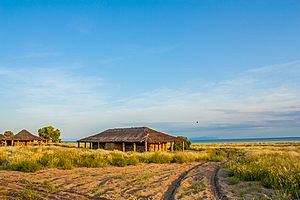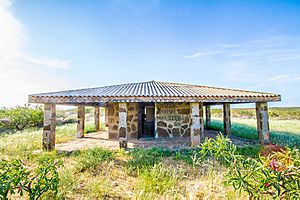Koobi Fora facts for kids
Koobi Fora is a special area in Kenya, East Africa, located on the eastern shore of Lake Turkana. This region is famous for its amazing discoveries of very old fossils, especially those of early human ancestors and ancient animals. Scientists call the whole area "East Turkana."
The land here is made of old layers of rock and soil, mostly from the Pliocene and Pleistocene periods (which means millions of years ago!). These layers hold many fossils of land animals, including early human-like species called hominins. Over time, rain and rivers have carved the land into a "badlands" shape, which helps expose these ancient layers.
In 1968, a famous scientist named Richard Leakey set up a base camp at Koobi Fora. Since then, many digs and surveys have shown that this region is a treasure trove of hominin fossils from the last 4.2 million years. Even more common than human fossils are the fossils of other animals and plants. These give us a great look at what life was like millions of years ago.
In 1973, the Kenyan government made this region a protected area called Sibiloi National Park. The park is well looked after, and its main goal is to protect the important fossil sites and the wildlife living there today.
The Koobi Fora Research Project (KFRP) works with universities and scientists worldwide to explore and dig for fossils in this area.
Contents
Discovering Ancient Life
Scientists divide the Koobi Fora region into many numbered areas to help them keep track of where fossils and tools are found. They use GPS to mark the exact spots.
Important Discovery Sites
Some areas in Koobi Fora are very famous for their finds:
- Area 105: This is where the first archaeological site, called FxJj 1, was found. It's also known as the KBS site. Here, researchers found some of the earliest stone tools ever discovered.
- Area 131: This area is famous for the discovery of skull 1470 in 1972. This skull was very important for understanding early human species. Scientists first thought it belonged to Homo habilis, but later named it Homo rudolfensis. It's one of the oldest Homo fossils found.
Fossils of Early Humans
Finding fossils in such a large area is a huge challenge! Richard Leakey created a special team of Kenyans, known as "the hominid gang." This team, led by Kamoya Kimeu, has found most of the more than 200 early human fossils in Koobi Fora.
Koobi Fora is well-known for fossils of the Homo genus (our own human group). But fossils of the Australopithecus genus, an older group of human relatives, have also been found.
Here are some of the early human species found at Koobi Fora:
| Species Name | Dates (Koobi Fora only) | What We Know |
|---|---|---|
| Australopithecus anamensis | 4.2-3.9 million years ago | These early human relatives were found at a place called Allia Bay. They show the earliest signs of walking on two legs. |
| Australopithecus boisei | 2.1-1.1 million years ago | This species had very strong jaws and teeth, likely for chewing tough plant foods. |
| Homo habilis | 1.9-1.6 million years ago | Often called "handy man," this species is thought to be one of the earliest members of our own Homo group. They were known for making simple stone tools. |
| Homo rudolfensis | 1.9-1.6 million years ago | This species is similar to Homo habilis but had a larger brain and flatter face. Skull 1470 is a famous example. |
| Homo ergaster | 1.8-1.4 million years ago | This species is seen as an early form of Homo erectus, which was the first human species to leave Africa. |
It seems that Australopithecus and Homo species lived in the Koobi Fora region at the same time for about a million years! Scientists think they survived by eating different kinds of food. Eventually, Australopithecus died out, and Homo continued to evolve into later human species.
Ancient Stone Tools
Many stone tools have been found at Koobi Fora. These tools are from the Paleolithic Age, which is also called the Old Stone Age. The tools found here are mainly of two types: Oldowan and Acheulean.
Here's how scientists describe the tool-making styles found at Koobi Fora:
| Tool Style Name | Dates | What It's Like |
|---|---|---|
| KBS Oldowan | 1.89-1.65 million years ago | These were simple tools, mostly choppers used for breaking bones or cutting meat. |
| Karari Oldowan | 1.65-1.39 million years ago | These tools were a bit more advanced, with more scrapers for preparing animal hides. |
| Early Acheulean | These tools included more complex shapes like handaxes, which were very useful for many tasks. |
As early humans changed from making Oldowan tools to Acheulean tools, they became more efficient. The Acheulean tools, especially the handaxe, allowed them to get more done with less effort. This meant they could process animal carcasses better, which might have reduced the need for constant hunting. Having better tools also meant they could travel further from where they found their stone, giving them more flexibility when hunting or gathering.
How Scientists Date the Past
Koobi Fora sits on top of very old volcanic rocks called basalts. Above these rocks are nearly 600 meters (about 2,000 feet) of layered sediments (like clay, silt, and sand) that built up over millions of years, from about four million to one million years ago.
Most of the early human fossils and tools are found in the upper parts of these layers. These layers show how the environment in the Turkana Basin changed over time, from a large lake and river delta to floodplains.
The layers of rock and soil at Koobi Fora are some of the best studied in East Africa. When scientists had trouble dating a specific layer called the KBS Tuff in the 1970s, it actually helped them create better ways to date very old rocks, using methods like potassium/argon and argon/argon dating. Because of this, Koobi Fora has become a key place for understanding how early humans and animals evolved in Africa.
See also
 In Spanish: Koobi Fora para niños
In Spanish: Koobi Fora para niños



